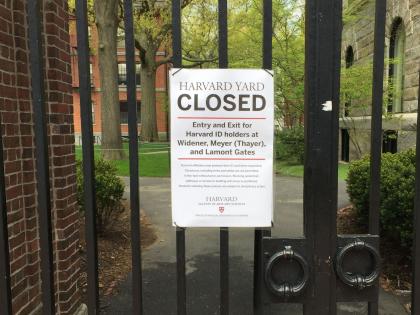Though her new novel begins with arson by a rebellious teen, Celeste Ng ’02 speaks warmly of her adolescence in Shaker Heights, Ohio, an affluent Cleveland suburb. The high school offered a lot of creative writing classes, she remembers, and had an extracurricular group focused on race relations. “It’s a wonderful place, and also very progressive,” she says of the town. Then she allows: “But also very regimented.” Shaker Heights was one of the first planned communities in the United States when it was founded in 1912. The roads ran into each other at strange angles to regulate traffic, and residents, banned from building pre-fab houses, were required to commission a unique architectural design in one of the three permitted styles (English, French, or Colonial).
American fiction about swimming-pool suburbia has long played on themes of bourgeois ennui and disillusionment; its writers gleefully tip over and trash the façades of white-picket-fence life. Little Fires Everywhere offers a variation on the genre in which there’s hardly a sour note. While quick to describe her characters’ flaws—both on the page and in a recent interview—Ng doesn’t disparage their ideal of a comfortable, liberal utopia, or their expectation that following the rules offers a clear path to happiness. Those notions may be a product of privilege, but the novel doesn’t treat them as fraudulent. Rather than serve as a focal object of social commentary, the suburbs—and their promise that safety and contentment can be found in a conventional life—provide a backdrop for human drama.
Little Fires Everywhere follows the well-to-do Richardsons, a prominent Shaker Heights family—Helena (usually referred to as Mrs. Richardson), her lawyer husband, and their children—as they rent their second house to some newcomers: art photographer Mia Warren and her daughter, Pearl. Where the Richardsons enjoy a deliberate and settled lifestyle, the Warren women lead a nomadic existence, constantly uprooting and starting fresh. Still, their households become entangled, with friendships, romances, mentorships, and business deals crisscrossing between them. When a custody battle over an adopted Chinese-American baby rocks the town, the friction between their worldviews erupts. The Richardsons side with the new parents, close friends of theirs who have longed for a child; Mia supports the birth mother, Bebe, who’d abandoned her baby at a fire station in a fog of desperation and post-partum depression.
The novel takes an omniscient perspective that shines a soft-focus light over this cast of characters, rendering all sympathetic. Even background figures, who come and go in a single chapter or parenthetical, get thumbnail-sketched backstories: the heroin-dealing cook has a sister who’s a single mother; the grouchy landlady alludes to some past tragedy. In this world, no one is perverse or rotten. Everyone’s fundamentally decent. People may behave badly or selfishly, but often, they’re just blinkered: Mrs. Richardson’s do-gooderism runs roughshod over the beneficiaries’ actual wants; her youngest child’s thwarted crush makes him lash out. Ng seems to empathize with each of her creations. Ticking off the Richardson children, she says, “Lexi, the oldest daughter, is the age that I would have been at the time, but is way cooler than I was. And Tripp is like the boys that I had crushes on. And Moody is much more like me, who is a little dorky, and not super cool. And Izzy is the radical that I would have liked to be, but was always too much of a goody two shoes to actually be.”
Ng’s prose keeps multiple perspectives in deft balance, the story passing smoothly from one viewpoint to another without any one of them dominating the whole. Her studious even-handedness comes out most strongly in scenes like the custody case hearing, toggling nimbly between the witnesses’ thoughts and the lawyers’ arguments over who can best raise the child: her birth mother, a single immigrant working a minimum-wage restaurant job, or the prosperous white couple who love the infant and can attend to her every need.Though trial scenes à la Atticus Finch have become a literary cliché, Ng says, “That part felt important to me—to let Ed Lim, who is this Chinese-American lawyer, have a say.” If the back-and-forth about cultural heritage verges on didactic, that’s due to her experience of what the audience needs. The book came together, in part, during the publicity tour for Everything I Never Told You, Ng’s debut novel about a mixed-race family in suburban Ohio whose child goes missing. During events, she reports, “People would say, ‘I’m so glad that I read this book, because I had no idea that Asians faced any discrimination.’”
Little Fires Everywhere feels as carefully planned as its setting, its thoroughfares orderly and lawns trimmed. Every action has a transparent motivation; each character gets a corresponding foil. Mrs. Richardson, the journalist, relentlessly hunts down the facts, while Mia, the artist, has a more intuitive grasp of people. Izzy longs to escape from the family whose acceptance Pearl craves. The legal drama opposes two mothers and their legal teams. The Richardsons are made up of two matched sets of brothers and sisters, one pair of golden children and one pair of misfits. If this design feels a little neat, even confining, it’s undeniably effective. The plot moves swiftly, powered by the complex machinery of withheld information, misunderstandings, and reveals. All the interdependent gears fit together snugly, from the very first, stunningly efficient, pages. Ng’s beginnings aren’t coy—they open with the main event (a fatality, a fire) and gather the principal characters around the wreckage, whether at the breakfast table or yards away from smoking ruins. In her words: “We've paraded them across the stage right at the start.”
Little Fires Everywhere sprawls in comparison to Everything I Never Told You, which stays within the isolated Lee household. Yet writing her first novel felt freer, she reports: “It’s a slightly different feeling if you know that you’re working with an audience.” After its release in 2014, it ascended to the New York Times bestseller list and year-end round-ups in outlets from NPR to Entertainment Weekly. With that success, and Ng’s cheerfully active Twitter presence, there’s a literary marketplace that’s designated her the young Asian-American novelist of the moment, and a readership that treats her as a go-to source for quotes about that racial experience.
“I could talk to you for another hour about that,” she says, recalling how at a recent cocktail party, an acquaintance told her about loving her previous book, and then asked, ingenuously, whether the next one was “also going to be about Asian people.” “And I didn’t know how to answer this question. Kind of? A little bit? Sort of not?” says Ng. “I’m aware that people are going to be like, ‘Where are the Asians?’” True, the central characters this time are white, but other concerns have carried over—motherhood, for example, or the burdens of inheritance. It’ll be interesting, she says, to watch how audiences will receive the new novel.
Recently, the author has dabbled in her character Mia’s medium. As novel research, she bought an old Brownie Starflex (teenage Mia’s starter camera, found in a junk shop) from Etsy for ten bucks. At the interview, she demonstrates how to use it: sling the strap around your neck, and the camera sits against the chest, with a silver-hooded viewfinder up top to peer into. It’s an extremely basic instrument—no frills, she says. “You can’t focus, you can’t do anything—you can’t control any kind of aperture or exposure or anything.” Ng still has to find a shop that will develop the film and send her the resulting prints. For now she can only point and shoot, and wait and see.
Follow Sophia Nguyen @sophiah_n.








